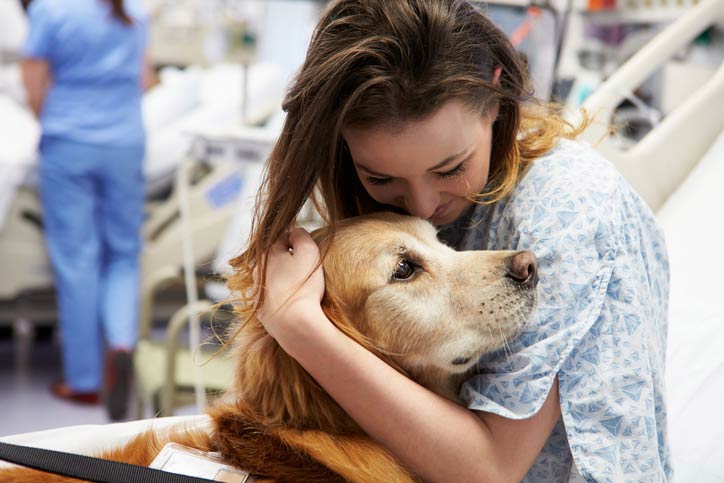You’ve likely heard a heartwarming story of a therapy dog helping someone in need—whether it’s a pet curling up with an elderly individual at a nursing home, sitting with a young child during a chemo treatment, or even helping students overcome bullying. There are many different facets of this type of work, but they all have one thing in common—they’re extremely rewarding to the owner, dog, and recipient alike. Hoping to get involved? Here are the answers to some of the most common questions by owners who are considering training their pet to become a registered therapy dog.
What Is a Therapy Dog?
Therapy dogs volunteer with their owners to sit quietly with people who need comfort or affection. Their work can range from visiting hospitals and senior centers to offering students comfort during final-exam week to helping children learn to read, and many dog–owner teams do a little of everything.
Can My Pet Be a Therapy Dog?
Like any job, there are qualifications that applicants must possess to be good candidates for the position. Every day, my dog-training school receives calls from people who want to train their dog to do therapy work. Their initial assumption is that all they need is a well-behaved dog, but that’s only one piece of the equation. The dog also has to want to be a therapy dog.
The reality is that although there are many dogs suited to do this work, there are also many who aren’t.
A dog has to have the physical and mental stamina to make it through a visit—the work is tiring and can be stressful for some animals.
They should also be calm. Case in point: My dog, Indy, is not a good fit for therapy work. Even though he’s highly trained, he’s also a ball of energy. During his “sit and stays,” he’s vibrating with excitement, heavily panting, and joyfully whipping his tail back and forth like he’s about to spontaneously combust. Unfortunately, that energy isn’t going to have the relaxing effects sought by the people he’s visiting. Sometimes the dogs we own are just not cut out for the job we want them to do.
Other qualities suitable therapy dog candidates possess include:
- A undiscriminating love for all people he meets
- A willingness to voluntarily seek out people to interact with
- A calm demeanor
- A tolerance for physical discomfort (At one of the very first visits I took my team on, a child got so excited to pet one of the dogs that he put the dog’s ear in a viselike grip and it took two aides to extract him.)
- Not easily spooked or unsettled (Therapy dogs may hear screaming, get stared at, walk on multiple types of surfaces, ride in elevators, and see and hear different types of equipment.)
How To Get Started
If your dog meets the criteria above, the first step is either to find an obedience class or to start training your dog on your own in the “basics.” All puppies and dogs in my school start in either puppy or beginner class, but at a certain point they switch to a therapy-geared class.
During the training process, do your research and find out what the different accrediting organizations require as part of their certification process. The AKC has a therapy-dog title that your dog can earn after he’s completed a certain number of visits and has been certified by an AKC-approved organization. Some of the major ones include:
- The Bright and Beautiful Therapy Dogs
- Love on a Leash
- Pet Partners (previously Delta Society)
- Alliance of Therapy Dogs (previously Therapy Dogs Incorporated)
One note: While there were once a few large national organizations, like those listed above, there is a growing trend for registration and certification of therapy dogs at the local level. The AKC works with therapy organizations all over the United States. A full list and more information about the therapy dog program can be found here.
Words of Encouragement
In my dog-training school, we have a very active therapy-dog training and visiting program, and the dogs and owners who are part of it are a very special group of individuals. Some of them passed their test with flying colors, a few had to retake it a time or two, and there were even those who realized their pet wasn’t therapy-dog material and instead trained a friend’s or relative’s pet. Best of luck with your journey into therapy work. It’s truly a gift for those who receive a visit from a therapy dog.
Kathy Santo trains dogs for home and competition at her Ramsey, New Jersey, school. She is the author of Kathy Santo’s Dog Sense and has handled multiple Obedience Trial Champions.


